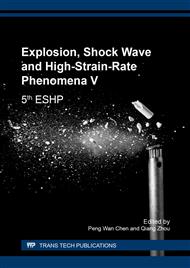p.123
p.130
p.137
p.143
p.149
p.155
p.161
p.169
p.176
Blast Wave Mitigation from the Straight Tube by Using Water Part I - Small Scale Experiment
Abstract:
A subsurface magazine has an explosive storage chamber, a horizontal passageway, and a vertical shaft for vent. It was proposed and legislated in Japan. The authors found that small amount of water on the floor of its storage chamber mitigated the blast pressure remarkably. The mechanism of the mitigation has been studied, however, it is not still well understood. In this study, the explosion in a transparent, square cross section, and straight tube was carried out to examine the mechanism of blast-wave mitigation by water. The arrangement and amount of water in the tube were varied for five ways. The dependence of mitigation effect on the arrangement and amount of water was evaluated by measuring the blast pressures in the tube and outside the tube. The results of this study concluded that the mitigation of blast wave by water is mainly due to the interaction between the explosion and the water very near the explosion point. On the contrary, the water at other part of the tube was found to strengthen the blast pressure.
Info:
Periodical:
Pages:
149-154
Citation:
Online since:
January 2018
Keywords:
Price:
Сopyright:
© 2018 Trans Tech Publications Ltd. All Rights Reserved
Share:
Citation:


